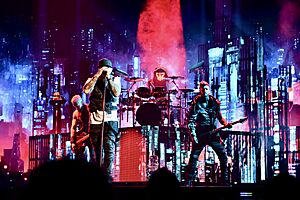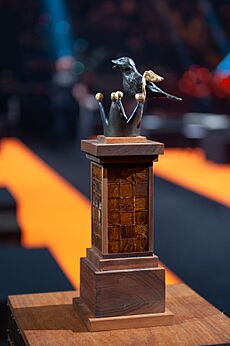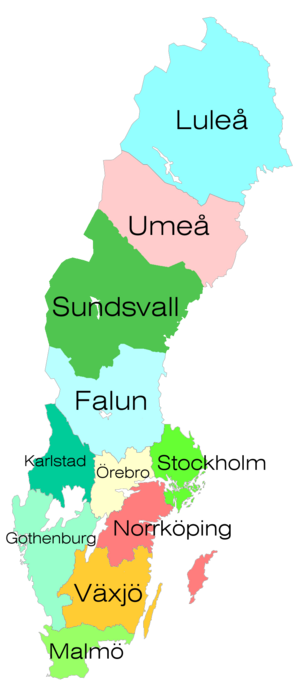Melodifestivalen facts for kids
Quick facts for kids Melodifestivalen |
|
|---|---|

Logo since 2016
|
|
| Genre | Song contest |
| Presented by | List of presenters |
| Country of origin | Sweden |
| Original language(s) | Swedish |
| No. of episodes | 63 |
| Production | |
| Production location(s) | Multiple cities in Sweden |
| Running time |
|
| Production company(s) | Sveriges Television |
| Release | |
| Original release | 29 January 1959 – present |
| Chronology | |
| Related shows |
|
Melodifestivalen (which means "the Melody Festival" in Swedish) is a big song competition held every year in Sweden. It's organized by Swedish TV (SVT) and radio (SR). The winner of Melodifestivalen gets to represent Sweden in the Eurovision Song Contest. This competition has been happening almost every year since 1959.
In the early 2000s, Melodifestivalen was the most popular TV show in Sweden. It's also broadcast on radio and the internet. In 2012, about 3.3 million people watched the early rounds, and over 4 million watched the final. That's almost half of Sweden's population!
Sweden has won the Eurovision Song Contest seven times thanks to Melodifestivalen. They've also placed in the top five 26 times. The winner of Melodifestivalen used to be chosen only by judges. But since 1999, the public can also vote by phone. Both the judges' votes and the public's votes have an equal say in who wins. The songs from the competition often become very popular in Sweden.
Since 2002, more songs can compete because of new "heat" rounds. The number of songs went from about 12 to 32. A children's version of the competition, called Lilla Melodifestivalen, also started that year. In the past, many songs were a type of pop music called schlager music. Because of this, some people called it "the schlager festival." But now, you can hear all kinds of music, like rap, reggae, and glam rock. The final show in Stockholm also brings many tourists to the city.
Contents
How Melodifestivalen Started
The first Eurovision Song Contest happened in Switzerland in May 1956. Sweden joined in 1958. Sveriges Radio (SR) chose Alice Babs to represent Sweden without a public competition. Her song, "Lilla stjärna" (meaning "Little star"), finished fourth at Eurovision.
The very first Melodifestivalen was on January 29, 1959. It was part of a radio show and had eight songs. Judges from different cities chose the winner. Siw Malmkvist won with "Augustin." But SR decided that Brita Borg would sing the winning song at Eurovision. This rule, where a different artist sang at Eurovision, stopped in 1961.
In 1960, the competition became its own TV show. It was called "Eurovisionschlagern, svensk final." It was even shown in Norway and Denmark. The competition got its current name, Melodifestivalen, in 1967.
Melodifestivalen has been cancelled three times. In 1964, it was cancelled because artists went on strike. Sweden didn't send a song to Eurovision that year. In 1970, Sweden didn't go to Eurovision because Nordic countries boycotted the voting system. This system had caused a four-way tie in 1969. After Sweden hosted Eurovision in 1975, some groups protested spending money on it again. So, Sweden didn't send a song in 1976 but returned in 1977.
Who Can Participate?
Many songs and performers have been part of Melodifestivalen since it started. For a long time, only Swedish songwriters could enter. But since 2012, foreign songwriters can submit songs if they work with a Swedish songwriter. To enter, songwriters and performers must be at least 16 years old by the day of the first Eurovision semi-final.
Before 2002, the competition was just one night. There were usually 5 to 12 contestants. Sometimes, between 1981 and 1998, they used a two-round system. If a famous artist didn't make it to the second round, it was seen as a big failure. For example, when Elisabeth Andreassen didn't qualify in 1984, it almost ended her music career.
When weekly heats started in 2002, the number of contestants grew to 32. At least 10 of the songs must be sung in Swedish. Since 2001, a CD of the songs is released every year. DVDs of the shows were released from 2003, but not recently due to digital music.
Melodifestivalen has helped many Swedish artists become famous, like ABBA, Tommy Körberg, and Lisa Nilsson. Performers from other countries have also taken part, such as Baccara and Katrina Leskanich. Even if an artist doesn't win, their song can still sell a lot in Sweden. For example, the song "Symfonin" by Loa Falkman came in last in 1990 but still topped the Swedish music charts. In 2008, songs from the festival made up the top 15 on the Swedish singles chart.
Choosing the Contestants
The process of picking songs for Melodifestivalen takes over seven months. SVT chooses half of the songs from public submissions. The other half are invited by SVT or chosen from other submissions. From 2012 to 2021, the last song was chosen through a competition called P4 Nästa. At least 10% of the songs must be in Swedish. The whole process starts in May of the year before and finishes in January.
Songs
SVT starts looking for songs nine months before Melodifestivalen begins. The deadline to submit songs is in September, and they can be in any language. Songs can be up to three minutes and twenty seconds long. If they make it to the final 28, they must be shortened to three minutes.
The Swedish Music Publishers Association (SMFF) helps reduce the number of songs. They get over 3,000 songs each year. They narrow it down to about 1,200. Then, a jury of 16 people, including music experts and SVT staff, chooses the final songs. The jury members are of different ages, from teenagers to people in their fifties. The chosen songs and their writers are announced in late September. This often leads to guesses about who will sing the songs. Songwriters who qualify must do interviews and attend press conferences.
Artists and Wildcards
SVT chooses the artists for the songs. Sometimes, the artist who recorded the demo version of a song will perform it in the competition. If they refuse, their song might be disqualified. This happened to Carola's "När löven faller" in 2003. SVT can also give songs to other performers.
The "wildcard" system was used from 2004 to 2012. Four artists were invited by SVT to enter a song of their choice. This helped bring different types of music to the show. Three wildcard songs have won the competition.
Where the Show Happens

The places where Melodifestivalen is held each year are announced in September. The early rounds (heats) take place in different towns and cities across Sweden. The Globe Arena (now Avicii Arena) in Stockholm hosted the final from 2002 to 2012. In 2013, the final moved to the new Friends Arena in Solna, near Stockholm.
In its early years, the event was held at one place: Cirkus in Stockholm. Cirkus has hosted the final 17 times. The Avicii Arena has hosted seven finals, and SVT's Stockholm headquarters has hosted five. The competition first took place outside Stockholm in 1975. Stockholm has hosted 37 finals in total. Gothenburg has hosted eight, and Malmö seven. The final has never been held outside these three cities.
Before 2002, if Sweden won Eurovision, the city that hosted Melodifestivalen the year before would host Eurovision. For example, Eurovision 1985 was in Gothenburg, 1992 in Malmö, and 2000 in Stockholm. Since 2002, Gothenburg's Scandinavium and Malmö's Malmö Arena have hosted many heats. In 2008, the Second Chance round was held in Kiruna, north of the Arctic Circle. Since 2013, the final has been at the Friends Arena. In 2021, all shows were held in Stockholm's Annexet without an audience due to the COVID-19 pandemic. In 2022, the pandemic still affected the show, with early heats at Avicii Arena and later shows at Friends Arena.
The TV Shows
Melodifestivalen happens over six Saturdays. It has six live shows: five heats, where six songs compete in each; and a final. Twelve songs make it to the final. Two songs from each heat qualify directly. After the fifth heat, a special vote picks two more songs to join the final.
Heats and Final Qualification
Before 2002, Melodifestivalen was usually just one live show. Now, five heats are shown live at 8:00 PM CET on Saturday nights. The heats start in early February. Six songs compete in each show.
In the heats, only public votes decide the results. The songs are performed live, and people can vote by phone. The two songs with the fewest votes are eliminated. The top four songs then compete for a spot in the final. The first and second-placed songs go straight to the final. The third and fourth-placed songs go to a final qualification round. The two finalists from each heat perform their songs again at the end of the show. This system of televised heats became popular in other Eurovision national selections. Eurovision itself adopted a similar system with semi-finals in 2004.
In 2024, the "Second Chance" show was removed. Instead, the third and fourth-placed songs from each heat go into a final qualification round at the end of the fifth heat. The top two songs from this round then go to the final.
The Grand Final
The final show takes place at 8:00 PM CET on a Saturday in early or mid-March. Twelve songs compete in the final. Two songs come from each heat, and two from the final qualification round. The order of the songs in the final is decided the week before. This is to make sure similar songs or artists are not placed next to each other. Dress rehearsals for the final are held on the Friday before, and tickets sell out very quickly. The final brings many tourists to Stockholm. In 2006, a survey showed that 54% of viewers traveled from outside the city.
The final show starts and ends with the EBU logo and special music. Short video clips introduce each song. During the show, while the judges are deciding and before voting closes, there are special performances. Past Melodifestivalen contestants have performed during these breaks.
The winner gets a trophy called Den stora Sångfågeln (meaning "The Great Songbird"). This trophy was first used in 2005. The winner performs their song again at the end of the show.
How Voting Works
Before 1999, only groups of judges from different regions or age groups chose the winner. In 1993, they tried using public phone voting, but it didn't work well. The phone network crashed because too many people called. Some newspapers even claimed the public vote changed the results a lot. SVT never confirmed this.
The current voting system started in 1999. It's similar to how voting works at the Eurovision Song Contest. Voting has two parts: first, judges announce their votes; then, the public voting results are announced. Both the public votes and the judges' votes have an equal 50/50 influence on the final result.
There are usually 11 groups of judges. Since 2010, these judges have represented different countries that participate in Eurovision. Until 2017, each jury gave points (1, 2, 4, 6, 8, 10, and 12) to their top seven songs. Since 2018, the points are 1 to 7, 8, 10, and 12 points.
After the judges vote, the public voting results are shown by the hosts, starting from the lowest points. Since 2019, public votes are separated by age groups. Each age group gives points (1 to 7, 8, 10, and 12) to the songs. The song with the most points at the end wins.
Phone lines open right after the final's radio preview and close after the judges have voted. People can vote by calling two different numbers for each song. One number lets them donate money to SVT's charity. Viewers can also vote by text message. Only people living in Sweden can vote.
The judges' votes are announced by spokespeople. They read the points in order, from one point to twelve. The host then repeats the points. Since 2010, most spokespeople announce the points in English, and the hosts repeat them in Swedish.
As the votes are announced, they are shown on a scoreboard. Melodifestivalen finals have broken Nordic voting records many times. In 2007, over two million people voted for the first time. The Swedish press covers Melodifestivalen a lot.
If there's a tie, the song that got more votes from the public wins. There have been two ties for first place in the contest's history. In 1969, Tommy Körberg tied with Jan Malmsjö. The judges then voted again to pick a winner, and Tommy Körberg won. In 1978, Björn Skifs tied with Lasse Holm and Wizex. A similar tie-break happened, and Skifs won.
Winners of Melodifestivalen
Almost all of Sweden's Eurovision representatives have come from Melodifestivalen. The 2020 winner was supposed to go to Eurovision, but that event was cancelled due to the COVID-19 pandemic. Sweden has won the Eurovision Song Contest seven times: in 1974, 1984, 1991, 1999, 2012, 2015, and 2023. As of 2023, Sweden is tied with Ireland for the most Eurovision wins.
ABBA's "Waterloo", which won Eurovision in 1974, was voted the most popular Melodifestivalen song ever in 2005. Later that year, it was also voted the most popular Eurovision song of the first fifty years. The table below shows Swedish entries that finished fifth or higher at Eurovision:
| Year | Song | Artist | Place at Eurovision |
|---|---|---|---|
| 1966 | "Nygammal vals" | Lill Lindfors and Svante Thuresson | 2nd |
| 1968 | "Det börjar verka kärlek, banne mej" | Claes-Göran Hederström | 5th |
| 1973 | "Sommaren som aldrig säger nej" | Malta | 5th |
| 1974 | "Waterloo" | ABBA | 1st |
| 1983 | "Främling" | Carola Häggkvist | 3rd |
| 1984 | "Diggi-Loo Diggi-Ley" | Herreys | 1st |
| 1985 | "Bra vibrationer" | Kikki Danielsson | 3rd |
| 1986 | "E' de' det här du kallar kärlek?" | Lasse Holm and Monica Törnell | 5th |
| 1989 | "En dag" | Tommy Nilsson | 4th |
| 1991 | "Fångad av en stormvind" | Carola Häggkvist | 1st |
| 1995 | "Se på mej" | Jan Johansen | 3rd |
| 1996 | "Den vilda" | One More Time | 3rd |
| 1999 | "Tusen och en natt" | Charlotte Nilsson | 1st |
| 2001 | "Lyssna till ditt hjärta" | Friends | 5th |
| 2003 | "Give Me Your Love" | Fame | 5th |
| 2004 | "Det gör ont" | Lena Philipsson | 5th |
| 2006 | "Evighet" | Carola Häggkvist | 5th |
| 2011 | "Popular" | Eric Saade | 3rd |
| 2012 | "Euphoria" | Loreen | 1st |
| 2014 | "Undo" | Sanna Nielsen | 3rd |
| 2015 | "Heroes" | Måns Zelmerlöw | 1st |
| 2016 | "If I Were Sorry" | Frans | 5th |
| 2017 | "I Can't Go On" | Robin Bengtsson | 5th |
| 2019 | "Too Late for Love" | John Lundvik | 5th |
| 2022 | "Hold Me Closer" | Cornelia Jakobs | 4th |
| 2023 | "Tattoo" | Loreen | 1st |
| 2025 | "Bara bada bastu" | KAJ | 4th |
Rules of the Competition
Most of Melodifestivalen's rules are based on the rules of the Eurovision Song Contest. But the Swedish broadcasters also have their own rules. These rules are released by SVT each year so that songwriters and performers know about any changes.
In the past, only six people were allowed on stage for each performance. This included the "house choir," a group of five backing singers. Artists could use these singers or their own. All singing had to be live; no human voices were allowed on backing tracks. However, since 2009, eight performers are allowed on stage, and voices can be on backing tracks. A live orchestra was used every year until 2000, except for 1985 and 1986. Since 2001, performers use pre-recorded backing tracks.
Songs cannot be publicly broadcast until the heats are previewed on radio. Songs that are eliminated in the heats can be broadcast right after the heat finishes. Songs that qualify for later rounds cannot be broadcast until the previews for the final qualification round are shown. After that, all restrictions are lifted.
Sometimes, winning songs are changed before they go to Eurovision. For example, in 1961, Siw Malmkvist won with "April, April." But she made a mistake and laughed during her performance. The press criticized her, so SR replaced her with Lill-Babs for Eurovision. Another example is the 1987 winner, "Fyra bugg och en Coca Cola." Its title was changed to "Boogaloo" for Eurovision because using a brand name was against the rules.
Until 1999, songs had to be in Swedish, except for a few years. But even then, most winning songs were recorded in English (and other languages) too. Since Eurovision removed its language rules in 1999, almost every Swedish entry has been in English, except for the 2025 entry. Other languages like Spanish, French, Greek, Italian, Portuguese, Bosnian, and Persian have also been featured. Cameron Cartio's song in 2005 was even in a made-up language.
How the Media Covers It
Melodifestivalen is shown on TV, radio, and the internet. It's broadcast on SVT1 and also on SVT World for international viewers, and later on SVT Play. The competition used to be on different TV channels depending on where it was held. Sveriges Radio broadcasts the event on SR P4, where it is currently broadcast.
The final is usually on a Saturday. In 1990, it was on a Friday, and in 1991, it was on Easter Sunday, to try and get more viewers. The 2002 final was delayed by a week because of the Winter Olympics.
The competition has had an official website since 1999. Live webcasts have been available since 2005. Since 2006, Sveriges Radio has had a radio station called P4 Melodifest dedicated to the competition. On P4, the public can preview the heat participants every Friday. The night after the final, there's a TV show called "dagen efter" (meaning "the day after"). It shows how the finalists feel after the competition. There is no commentary for the TV broadcast. Carolina Norén is the commentator for Sveriges Radio. The festival has been broadcast in widescreen since 2002 and with better sound (Dolby Digital) since 2004.
The number of people watching the competition has been growing since 2002. In 2007, about 4.1 million Swedes watched the final. That's almost 44% of the country's population. Between 2.9 million and 3.2 million people watched each of the heats. Melodifestivalen gets a lot of attention in the Swedish newspapers. A study found that news coverage might have influenced the results of the 2007 festival.
Music Styles and Showmanship
Melodifestivalen's style has changed over time. But one word has often described its music: schlager. In Sweden, schlager means any song connected to the competition. This includes the jazz music from the 1960s and more modern songs. One writer described Swedish schlager as "a catchy, repeating tune and simple lyrics."
Jazz artists like Monica Zetterlund won in the 1960s. ABBA, who won Eurovision in 1974, became Sweden's most famous music export. They influenced not only Melodifestivalen but also Swedish music in general. In the 1980s, record labels made many "easy, memorable tunes." In the early 2000s, the competition started to have more variety. For example, Afro-dite won with a disco song in 2002, and The Ark won with a "retro glam rock" song in 2007.
Performers often use special effects and tricks on stage. Lena Philipsson used a microphone stand in a unique way in her 2004 performance. When she hosted Melodifestivalen in 2006, funny short films were shown about what happened to that microphone stand. Fireworks are also a common special effect in Melodifestivalen.
See also
 In Spanish: Melodifestivalen para niños
In Spanish: Melodifestivalen para niños
- Lilla Melodifestivalen





